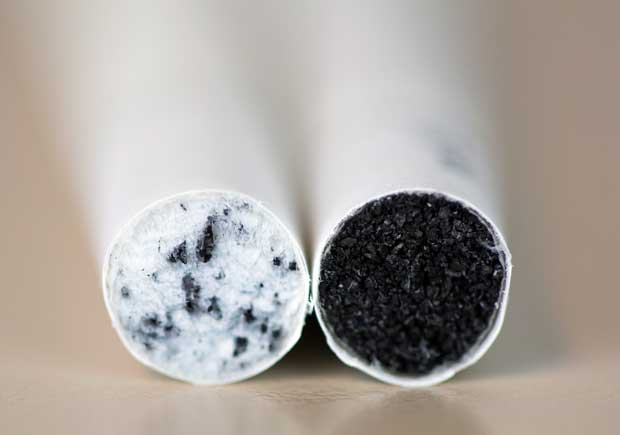The latest filter technology from Celanese uses active carbon to reduce toxicants in cigarette smoke without the loss of desired nicotine.
By Timothy S. Donahue
Innovation in the tobacco industry proceeds at a comparatively slow pace. When advances do happen, they are usually quite revolutionary. Celanese Corp. proves that point with its latest breakthrough in cigarette filter technology. Commercially launched in Japan in late 2014, Celanese’s new CelFX filter is proven to not only remove more gas-phase compounds but also enhance the consumer’s smoking experience.
“This revolutionary cigarette filter delivers a taste and experience consumers want while dramatically reducing many of the toxicants in smoke,” says Perry Aliotti, vice president of global cellulose derivatives sales at Celanese. “CelFX provides all the satisfaction and flavor of smoking with less of the compounds of concern.”
Several factors set CelFX apart from traditional carbon cigarette filters. One of these is that CelFX comprises just four ingredients, three of which are already being used daily by manufacturers of carbon-filtered cigarettes. CelFX uses an industry-standard carbon, paper and glue. The fourth ingredient, a high-tech binder, is a well-known and well-studied material listed as approved for use in filters under the German tobacco ordinance. The binder even meets stringent food and drinking water contact requirements.
CelFX filters are also a drop-in solution for manufacturers. The rods run on standard combiners and cigarette makers with no new parts needed, so no capital investment. Because the binder holds tightly to the carbon particles, the rods run cleaner with less dust. Additionally, CelFX rods have no shelf life limitation—that is a further benefit over carbon-on-tow filters, which can sour with age.
“Using industry-standard carbon was important for helping our customers quickly accept the platform. We can use other carbons, but we don’t need to,” says Kevin Norfleet, commercial manager for CelFX at Celanese. “We get four times more carbon in our filter than in normal filters. Specialized carbons are an option, but generally we have all the activity and performance we need with standard carbon.”
At its core, the CelFX technology binds carbon or other potential additives together into a highly efficient structure for filtration. Large amounts of carbon can be securely fixed into a porous matrix while keeping up to 90 percent of the surface area available. That means that the micropores in carbon—key to selective filtration of gas-phase compounds—are not only still available but also presented uniformly and evenly to the smoke stream, making the filter significantly more efficient.
Additionally, that porous structure enables draw resistance to be tightly controlled so that no changes occur in tar or nicotine levels. “Essentially, CelFX maximizes the surface area of the carbon available to smoke without sacrificing product performance,” says Norfleet. “CelFX gives product designers new freedom to innovate.”
Third-party testing has shown the increased carbon in CelFX helps to reduce the levels of certain toxic compounds dramatically when compared to other types of cigarette filters, according to Aliotti. The World Health Organization has a list of known tobacco smoke toxicants, some of which are gases. “We filter up to 80 percent more of those gas-phase toxicants than mono-acetate filters and up to 60 percent more than carbon-on-tow,” says Norfleet. “While others are looking at reducing tar to reduce toxicants in smoke, we are reducing the gases while maintaining tar, nicotine and flavor. Things like benzene, acetaldehyde, acrylonitrile, formaldehyde, 1,3-butadiene, hydrogen cyanide, isoprene and more are all significantly reduced.”
Aliotti says that the construction of CelFX is unlike anything seen in the industry before. “We can hold the carbon within the filter, evenly spaced out in such a way that even with high carbon loading, it can achieve as gentle an airflow as a normal acetate filter with no risk of collapse or bypass,” he says. “For the cigarette industry, this is as revolutionary as ventilation. Plus, consumers really notice the extra firmness of CelFX and like that firm segment when they extinguish their cigarette.”
Teamwork
CelFX technology is a result of Celanese’s devotion to teamwork and unity among its scientists. Celanese developed the CelFX technology through collaboration between two of its divisions: Cellulose Derivatives (CD) and Engineered Materials (EM). The two sides joined forces and set out to develop and commercialize a new technology that could cleanly and simply put high levels of carbon into a cigarette filter.
The CD side had a long history of working within the tobacco industry, supplying acetate tow for manufacturers worldwide. The EM division excelled at producing various high-technology plastics, including the leading binder technology used in producing water filters. One day, team leaders got together and discussed how the two divisions could create an ancillary tobacco product using their combined products and experience.
“We decided to see if we could make a porous block suitable for the tobacco industry,” says Aliotti. “We knew we had something when we started testing lab-made products, but it took a long time to adapt the binder technology and develop our own process. Fortunately, teamwork and perseverance allowed us to perfect it and to take CelFX to market.”
The CelFX technology is more than just a significant step forward for manufacturers. Beyond simply improving filtration, the benefits in taste and filter feel offer tangible features for consumers as well.
“This marriage of the best water- and smoke-filtration technologies results in a filter that can outperform both carbon-on-tow and cavity filters in taste, ease of draw, filtration efficiency and cleanliness,” says Norfleet. “Additionally, Celanese has a proprietary process to produce CelFX at the scale required to properly serve the industry. Our production facility that is established in the U.S. has proven fully capable of meeting the demanding quality and product requirements of the tobacco sector at a viable price point.”
The CelFX filter is available in a full range of lengths and sizes, from super-slim to standard. The brand Floyd was launched by Montepaz in Japan as the first to incorporate the CelFX technology and has had such good success that the Uruguay-based cigarette manufacturer has now launched the brand in Colombia as well. In fact, Celanese will announce several additional customer partnerships with CelFX in 2016, according to Aliotti. “We are very excited about the future of this product.”













